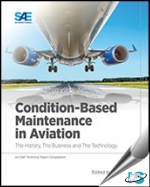Tab Article
Condition-Based Maintenance in Aviation: The History, The Business and The Technology describes the history and practice of Condition-Based Maintenance (CBM) systems by showcasing ten technical papers from the archives of SAE International, stretching from the dawn of the jet age down to the present times.
By scientifically understanding how different components degrade during operations, it is possible to schedule inspections, repairs, and overhauls at appropriate intervals so that any incipient failure can be detected well in advance.
Today, this includes more sensors and analytics so that periodic inspections are replaced by automated “continuous” inspections, and analytical methods that detect imminent failures and predict degradation issues more economically and efficiently.
Similar concepts are also being developed for delivering prognostics functions, such as tracking of remaining useful life (RUL) of life-limited parts in aircraft engines.
The discipline within CBM that deals with this is called prognostics and health management (PHM), which covers all aspects of diagnostics and prognostics, including modeling of systems and subsystems, sensing, data transmission, storage and retrieval, analytical methods, and decision making.
Traditionally, nondestructive testing (NDT) methods have been employed during the major airplane checks to assess structural damage. These techniques are enhanced with in- situ sensing techniques that can continuously monitor aircraft structures and report on their health.
The move to condition-based assessment of maintenance needs to be balanced by the assurance that safety is not compromised, that initial cost of new equipment is amortized by the savings, and that regulatory authorities are on board with any modifications to the planned maintenance schedule. The trend is clearly to include more CBM functions into Maintenance, Repair and Overhaul (MRO) processes so better cost control can be achieved without ever comprising passenger safety.


